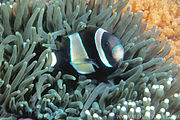トウアカクマノミ
| トウアカクマノミ | |||||||||||||||||||||||||||
|---|---|---|---|---|---|---|---|---|---|---|---|---|---|---|---|---|---|---|---|---|---|---|---|---|---|---|---|

| |||||||||||||||||||||||||||
| 保全状況評価[1] | |||||||||||||||||||||||||||
| LEAST CONCERN (IUCN Red List Ver.3.1 (2001)) 
| |||||||||||||||||||||||||||
| 分類 | |||||||||||||||||||||||||||
| |||||||||||||||||||||||||||
| 学名 | |||||||||||||||||||||||||||
| Amphiprion polymnus (Linnaeus, 1758) | |||||||||||||||||||||||||||
| シノニム | |||||||||||||||||||||||||||
| |||||||||||||||||||||||||||
| 英名 | |||||||||||||||||||||||||||
| saddleback clownfish yellowfin anemonefish |
トウアカクマノミ (学名:Amphiprion polymnus)は、スズメダイ科に分類される海水魚の一種。和名の通り口先が赤く、体色は黒と白で鞍状の模様がある[2]。イソギンチャクと共生しており、触手の影響は受けない。厳密な順位制を持っており、繁殖雌が最も大きく、繁殖雄が次に大きく、非繁殖雄は順位が下がるにつれて体も小さくなる[3]。繁殖雌が死亡すると繁殖雄が性転換し、最大の非繁殖雌が繁殖雄になる[4]。
形態[編集]
全長は最大で13 cmに達する。クマノミ属の種は雌の方が大きいことが多いが、本種は雌雄の大きさがほぼ同じである。体は側扁した楕円形で、丸みを帯びている[5]。体色は暗褐色から黄色がかったオレンジ色で、目の後ろには太く白い横帯が通り、体の中央には鞍型の白い模様があり、その模様が延長して尾柄に白い帯が入る場合もある[4]。尾鰭と臀鰭は白く縁取られる。吻と胸鰭はオレンジ色。共生相手であるイソギンチャクの種類によって体色を変え、水槽内では数時間で変化する[4]。背鰭は10 - 11棘と16 - 18軟条から、臀鰭は2棘と12 - 14軟条から成る[6]。
類似種[編集]
A. sebae と A. latezonatus に模様は似るが、系統的に A. latezonatus は近縁では無い[7]。A. sebae は尾鰭が黄色いので区別は容易[4]。
-
トウアカクマノミの雌雄。大きさはほぼ同じである
-
A. sebae は尾鰭が黄色い
分布と生態[編集]
主にフィリピンからインドネシア、ニューギニアに至るインド太平洋中部に分布する[6]。その他にも、オーストラリア北部、メラネシア、日本で見られる[4]。日本では稀種で、沖縄本島以西の南西諸島の一部で記録がある[2]。水深2 - 30 mのラグーンや湾に生息する[8][9]。
シライトイソギンチャク、イボハタゴイソギンチャクと共生する[4][10]。卵は親が運んできた岩などに産み付けられ、親が新鮮な海水を送り込んで維持する[6]。動物プランクトン、小型の甲殻類、藻類を捕食する[11]。昼行性で縄張り意識は強く、イソギンチャクへの依存度が強い。他の種に比べ雄が大型である理由は、素早く泳げるため捕食者から逃れやすくなるからであると考えられている[12]。
人との関わり[編集]
温暖化、海の酸性化によるイソギンチャクの白化の影響を受けている。また飼育の為に多数捕獲されており、クマノミ属の取引量のうち、75%が野生個体であった[13][14]。これにより一部地域では生息密度が低下しており[15]、イソギンチャクの白化が促進されることが懸念されている[16]。
脚注[編集]
- ^ Jenkins, A.; Allen, G.; Myers, R.; Yeeting, B. & Carpenter, K.E. (2017). “Amphiprion polymnus”. IUCN Red List of Threatened Species 2017: e.T188579A1896440. doi:10.2305/IUCN.UK.2017-2.RLTS.T188579A1896440.en.
- ^ a b 『クマノミ全種に会いに行く』75頁
- ^ Buston PM (May 2004). “Territory inheritance in clownfish”. Proc. Biol. Sci. 271 (Suppl 4): S252–4. doi:10.1098/rsbl.2003.0156. PMC 1810038. PMID 15252999.
- ^ a b c d e f Fautin, Daphne G.; Allen, Gerald R. (1997). Field Guide to Anemone Fishes and Their Host Sea Anemones. Western Australian Museum. ISBN 9780730983651. オリジナルの18 October 2014時点におけるアーカイブ。
- ^ Lieske, E.; Myers, R. (2001). Coral reef fishes. Princeton University Press. ISBN 9780691089959
- ^ a b c Froese, Rainer and Pauly, Daniel, eds. (2024). "Amphiprion polymnus" in FishBase. March 2024 version.
- ^ Litsios, G.; Sims, C.; Wüest, R.; Pearman P.B.; Zimmermann, N.E.; Salamin N. (2012). “Mutualism with sea anemones triggered the adaptive radiation of clownfishes”. BMC Evolutionary Biology 12 (11): 212. Bibcode: 2012BMCEE..12..212L. doi:10.1186/1471-2148-12-212. PMC 3532366. PMID 23122007.
- ^ Allen, Gerald R. (1991). Damselfishes of the world. Mergus. ISBN 9783882440089
- ^ “Saddleback Anemonefish, Amphiprion polymnus”. Fishes of Australia. 2024年3月2日閲覧。
- ^ Ollerton J; McCollin D; Fautin DG; Allen GR. (2007). “Finding NEMO: nestedness engendered by mutualistic organization in anemonefish and their hosts”. Proc R Soc B Biol Sci 274 (1609): 591–598. doi:10.1098/rspb.2006.3758. PMC 1766375. PMID 17476781.
- ^ Vilcinskas, Andreas (2002) (フランス語). La vie sous-marine des tropiques [Marine life of the tropics]. Paris: Vigot. ISBN 978-2-7114-1525-0
- ^ Moyer, J.T.; Steene, R.C. (1979). “Nesting Behavior of the Anemonefish Amphiprion polymnus”. Japanese Journal of Ichthyology 26 (22). doi:10.11369/jji1950.26.209.
- ^ Dhaneesh, K.V.; Vinoth, R.; Gosh, S.; Gopi, M.; Kumar, T.T. Ajith; Balasubramanian, T. (2013). “Hatchery Production of Marine Ornamental Fishes: An Alternate Livelihood Option for the Island Community at Lakshadweep”. In Sundaresan, J.. Climate Change and Island and Coastal Vulnerability. 17. pp. 253–265. doi:10.1007/978-94-007-6016-5_17. ISBN 978-94-007-6015-8
- ^ Taylor, M.; Green, E. & Razak, T. (2003). From ocean to aquarium: A global trade in marine ornamental species. UNEP world conservation and monitoring centre (WCMC). pp. 1–64 2024年3月2日閲覧。
- ^ Shuman, Craig; Hodgson, Gregor; Ambrose, Richard F. (2005). “Population impacts of collecting sea anemones and anemonefish for the marine aquarium trade in the Philippines”. Coral Reefs 24 (4): 564–573. Bibcode: 2005CorRe..24..564S. doi:10.1007/s00338-005-0027-z.
- ^ Jones, A.M.; Gardner, S.; Sinclair, W. (2008). “Losing 'Nemo': bleaching and collection appear to reduce inshore populations of anemonefishes”. Journal of Fish Biology 73 (3): 753–756. Bibcode: 2008JFBio..73..753J. doi:10.1111/j.1095-8649.2008.01969.x.
参考文献[編集]
- 中村庸夫『クマノミ全種に会いに行く』平凡社 ISBN 4-582-54235-2



